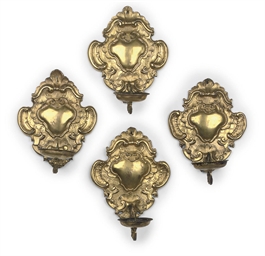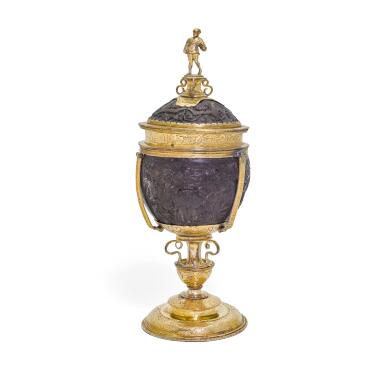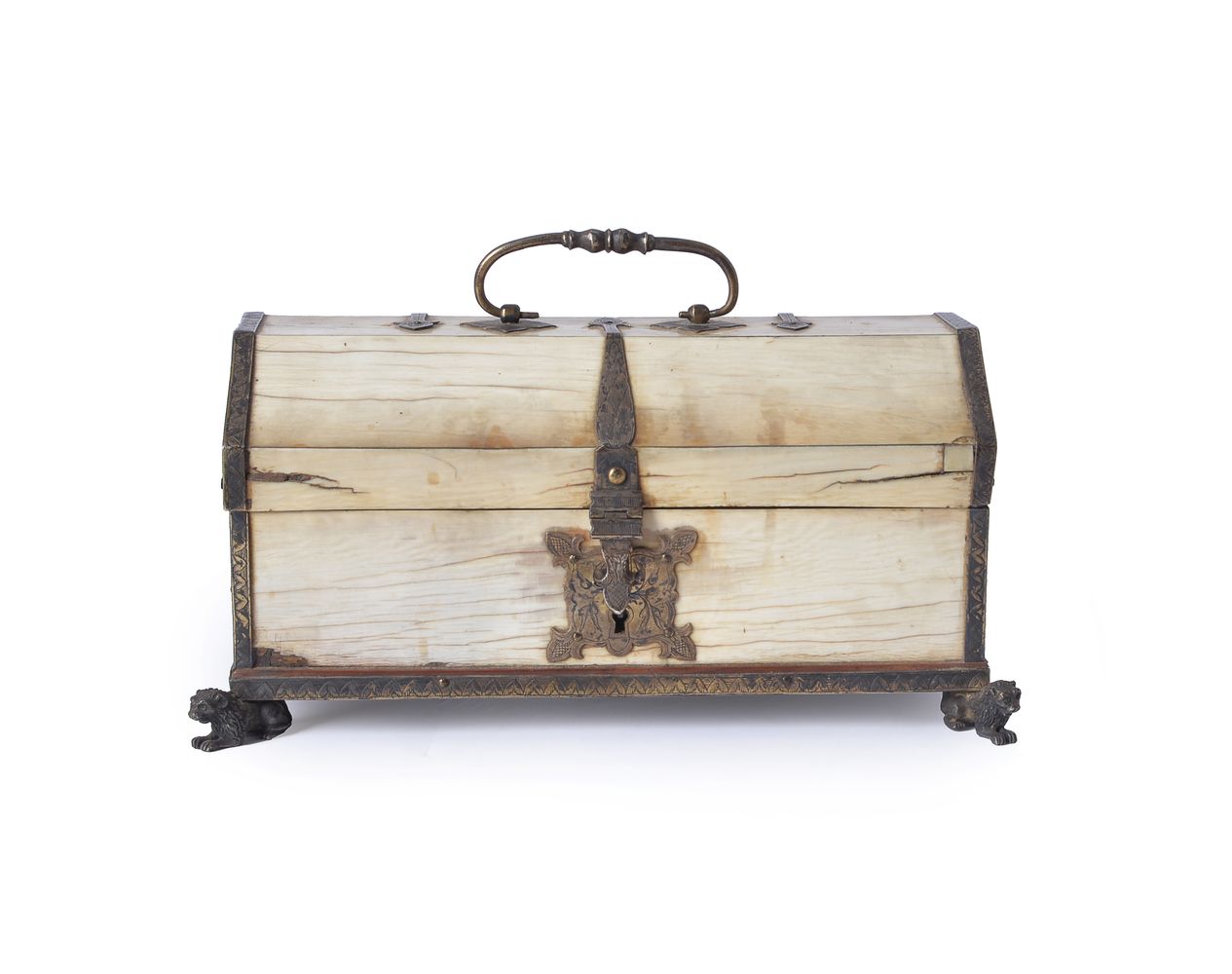A German gilt copper and brass crucifix clock Attributed to Hans Schlottheim, Augsburg, circa 1600 and later The circular gilt brass full plate verge movement with scroll engraved standing barrels for both the going and strike trains, the going train with sprung three-arm steel balance set behind leafy foliate scroll engraved and pierced backcock now with rack and pinion regulation with silvered disc to the adjustment square, the backplate originally fitted with stackfreed (cam and spring now lacking), the strike train with recessed steel countwheel driven by spur pinion engaging with teeth cut to the inside edge and hammer set between the plates sounding on a pork pie shaped bell mounted within the case behind the movement, the backplate with delicate foliate scroll engraved border incorporating hatched panel inscribed with the initials H S, the movement mounted onto hinged cover with herringbone engraved inner border, the exterior now fitted with later silver coloured metal cylindrical section crucifix surmount with cast Corpus Christi beneath cream painted rotating sphere with Roman numeral annular chapters, the circular gilt copper base with naturalistic engraved decoration and leafy ogee-shaped border to the platform cover above arcade-pierced frieze enclosing the bell flanked by a pair of vase-and-spire turned gilt finials and open scroll cast mounts applied to the broad ogee-outline foot engraved with fruiting foliage and scrolling strapwork on a matted ground within leafy outer ring moulding, on three small brass bun feet, 33cm (13ins) high, diameter of movement 5.7cm (2.25ins). Hans Schlottheim is recorded in Maurice, Klaus and Mayr, Otto THE CLOCKWORK UNIVERSE, GERMAN CLOCKS AND AUTOMATA 1550-1650 as a protestant 'large and small' clockmaker who was born circa 1544-7 in Naumburg, Saxony. He is thought to have moved to Augsburg in 1567 and served as journeyman to the highly important clockmaker Jeremias Metzger over the winter of 1573-4. In 1573 he married Ursula, the widow of the master locksmith Hans Schitterer, through whom he gained a workshop and 'eligibility' to work (as well becoming related to the Fronmiller family of clockmakers). Schlottheim became a master in 1576 and entered into his second marriage with Euphrosina Osswald in 1606. In 1586 he was appointed the foreman of his guild before spending considerable time in Dresden (in 1589 and 1593) as well Prague (in 1587 and 1601). By 1599 Schlottheim was in financial difficulty, mainly due to outstanding payments for commissions undertaken for the Imperial Court. This required him to (successfully) demand support from the city of Augsburg, a situation that was unfortunately repeated in 1615; he is thought to have died around ten years later in around 1625. Schlottheim is known for producing numerous important clocks and complex automata including, in 1577, the first public quarter-striking clock to be installed in Augsburg. In 1582 he made an impressive architectural musical trumpeter automaton for Duke Wilhelm V of Bavaria, which is now housed in the Kunsthistoricshes Museum, Vienna, alongside others including 'The Triumph of Bacchus' automaton made in around 1605 and a fine mechanical 'nef' similar to the famous example by him given to the British Museum by Octavius Morgan in 1866. Another complex automaton by Schlottheim, known as the 'Christmas Navity' (which was apparently commissioned for the Ottoman Emperor in around 1684), survives as a fragment in Dresden along with another impressive clock with rolling ball called 'The Tower of Babel' made for the Duchess of Graz in around 1600. Many other smaller clocks by Schlottheim also survive in museum collections, including a crucifix clock at Moyse's Museum, Bury St. Edmonds, Suffolk (object number BSEMS:1992.1.58). This example is very closely related to the current lot with both sharing the same basic layout of movement (although the stackfreed and stopwork is intact on the museum example) and design of ba
A German gilt copper and brass crucifix clock Attributed to Hans Schlottheim, Augsburg, circa 1600 and later The circular gilt brass full plate verge movement with scroll engraved standing barrels for both the going and strike trains, the going train with sprung three-arm steel balance set behind leafy foliate scroll engraved and pierced backcock now with rack and pinion regulation with silvered disc to the adjustment square, the backplate originally fitted with stackfreed (cam and spring now lacking), the strike train with recessed steel countwheel driven by spur pinion engaging with teeth cut to the inside edge and hammer set between the plates sounding on a pork pie shaped bell mounted within the case behind the movement, the backplate with delicate foliate scroll engraved border incorporating hatched panel inscribed with the initials H S, the movement mounted onto hinged cover with herringbone engraved inner border, the exterior now fitted with later silver coloured metal cylindrical section crucifix surmount with cast Corpus Christi beneath cream painted rotating sphere with Roman numeral annular chapters, the circular gilt copper base with naturalistic engraved decoration and leafy ogee-shaped border to the platform cover above arcade-pierced frieze enclosing the bell flanked by a pair of vase-and-spire turned gilt finials and open scroll cast mounts applied to the broad ogee-outline foot engraved with fruiting foliage and scrolling strapwork on a matted ground within leafy outer ring moulding, on three small brass bun feet, 33cm (13ins) high, diameter of movement 5.7cm (2.25ins). Hans Schlottheim is recorded in Maurice, Klaus and Mayr, Otto THE CLOCKWORK UNIVERSE, GERMAN CLOCKS AND AUTOMATA 1550-1650 as a protestant 'large and small' clockmaker who was born circa 1544-7 in Naumburg, Saxony. He is thought to have moved to Augsburg in 1567 and served as journeyman to the highly important clockmaker Jeremias Metzger over the winter of 1573-4. In 1573 he married Ursula, the widow of the master locksmith Hans Schitterer, through whom he gained a workshop and 'eligibility' to work (as well becoming related to the Fronmiller family of clockmakers). Schlottheim became a master in 1576 and entered into his second marriage with Euphrosina Osswald in 1606. In 1586 he was appointed the foreman of his guild before spending considerable time in Dresden (in 1589 and 1593) as well Prague (in 1587 and 1601). By 1599 Schlottheim was in financial difficulty, mainly due to outstanding payments for commissions undertaken for the Imperial Court. This required him to (successfully) demand support from the city of Augsburg, a situation that was unfortunately repeated in 1615; he is thought to have died around ten years later in around 1625. Schlottheim is known for producing numerous important clocks and complex automata including, in 1577, the first public quarter-striking clock to be installed in Augsburg. In 1582 he made an impressive architectural musical trumpeter automaton for Duke Wilhelm V of Bavaria, which is now housed in the Kunsthistoricshes Museum, Vienna, alongside others including 'The Triumph of Bacchus' automaton made in around 1605 and a fine mechanical 'nef' similar to the famous example by him given to the British Museum by Octavius Morgan in 1866. Another complex automaton by Schlottheim, known as the 'Christmas Navity' (which was apparently commissioned for the Ottoman Emperor in around 1684), survives as a fragment in Dresden along with another impressive clock with rolling ball called 'The Tower of Babel' made for the Duchess of Graz in around 1600. Many other smaller clocks by Schlottheim also survive in museum collections, including a crucifix clock at Moyse's Museum, Bury St. Edmonds, Suffolk (object number BSEMS:1992.1.58). This example is very closely related to the current lot with both sharing the same basic layout of movement (although the stackfreed and stopwork is intact on the museum example) and design of ba











Testen Sie LotSearch und seine Premium-Features 7 Tage - ohne Kosten!
Lassen Sie sich automatisch über neue Objekte in kommenden Auktionen benachrichtigen.
Suchauftrag anlegen